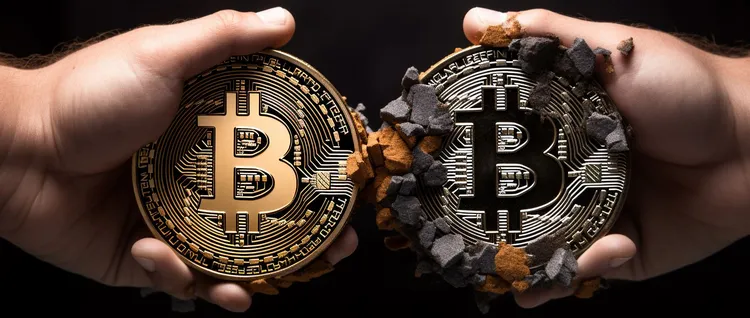How many bitcoins are there?
Das Wichtigste in Kürze:
- Es gibt maximal 21 Millionen Bitcoin; etwa 19,7 Millionen wurden bereits abgebaut.
- Rund 20 % der Bitcoins sind verloren und nicht wiederherstellbar.
- Restlichen Bitcoins werden voraussichtlich bis 2140 abgebaut, danach keine neuen.
- Bitcoin Halving reduziert die Belohnung für Miner und beeinflusst den Preis stark.
- Es gibt auch andere Kryptowährungen mit begrenzter Stückzahl wie Binance Coin und Litecoin.
Number of total Bitcoin
We established at the beginning that there is a limited number of bitcoins in the world. Only 21 million Bitcoin can exist in total. Currently, (July 2024) around 19.7 million Bitcoin have been mined, with around 1.3 million still missing. So, the bitcoin currently in circulation has already been mined. Bitcoin mining is getting harder and harder.
On the one hand, this is because fewer and fewer bitcoins are available, and on the other hand, more and more people are certainly taking part in this process. Since it is ultimately about computing power, a correspondingly strong hardware is a basic requirement. For a private individual with effective mining hardware, it currently takes around 4 to 5 years on average to mine one bitcoin.
If you are interested in digitally mining Bitcoin yourself, you will have to expect a high investment right from the start. The necessary hardware is currently difficult to get hold of and relatively expensive at the same time. However, if the Bitcoin price continues to grow strongly, this could still be a lucrative business.
Can New Bitcoins Enter Circulation?
It is projected that by 2140, the total supply of 21 million Bitcoins will be reached. The fact that many of these Bitcoins are permanently lost is inconsequential to this milestone.
It's unlikely that new Bitcoins will enter circulation beyond this point. An increase in the maximum supply would only be possible through a uniform and widespread change to the protocol. Such a change would require the unanimous support of the entire Bitcoin community.
Given that the limited supply is a fundamental tenet of Bitcoin, it's improbable that such an alteration will ever occur. To date, there are no indications from the community suggesting a raise in the upper limit is on the horizon.
Can Lost Bitcoins Be Recovered?
Over the years, it's estimated that about 20% of the bitcoins in circulation have been lost due to various reasons, from damaged hard drives and forgotten passwords to lost keys. As Bitcoin continues to gain popularity and its quantity steadily decreases due to halvings, many wonders whether these lost bitcoins can be recovered.
Unfortunately, the answer is no. Recovering lost bitcoins is nearly impossible, especially if they are not personally yours. If they are your own, there might be a chance to recover lost keys or regain access in other ways, but such instances are quite rare.
Bitcoin as a Deflationary Currency
Bitcoin stands as a beacon of deflationary currency in a world dominated by fiat currencies. Unlike their traditional counterparts, Bitcoin's supply is rigidly fixed at 21 million coins. This characteristic comes with a host of advantages, including:
- Enhanced Predictability: With a predetermined supply, Bitcoin offers a level of predictability that is often elusive in traditional financial systems.
- Heightened Independence: Operating outside the grasp of centralized institutions, Bitcoin carries a sense of financial autonomy that empowers its users.
- Investment Potential: The scarcity inherent in its design imbues Bitcoin with the potential to serve as both a means of transaction and an investment vehicle.
- Safeguard Against Devaluation: As a deflationary asset, Bitcoin provides a shield against the erosive effects of inflation, which can erode the value of traditional currencies.
- Appreciation Through Scarcity: The limited supply fuels the potential for value appreciation over time, a phenomenon that echoes the allure of precious commodities.
Given these multifaceted advantages, the surging embrace of Bitcoin comes as no surprise. Yet, it's essential to note that Bitcoin is far from the solitary player in the realm of limited-supply cryptocurrencies. The cryptocurrency landscape is rich with innovation, where various digital assets proudly sport their own unique qualities and aspirations. As the future unfolds, these currencies, including Bitcoin, will continue to carve their distinct paths, collectively shaping the financial landscape of tomorrow.
What is Bitcoin Halving?
The Bitcoin Halving, a pivotal event occurring every four years, is an integral facet of the coin's monetary policy. During this event, miner rewards are cut in half, resulting in fewer Bitcoins being received for the mining of a new block. This reduction also influences the total number of newly minted Bitcoins.

The amount of Bitcoin awarded decreases exponentially with each halving event until the maximum limit of 21 million Bitcoins is reached. Since the average time it takes to mine a block is 10 minutes, this limit is expected to be reached by the year 2140. Initially, the reward for mining a block was 50 Bitcoins. This reward was reduced to 25 Bitcoins in 2012, to 12.5 Bitcoins in 2016, to 6.25 Bitcoins in 2020, and to 3.125 Bitcoins in the last halving in April 2024.
When is the Next Bitcoin Halving?
The next halving event is expected to occur in April 2028. At that time, the reward will be reduced from 3.125 to 1.5625 Bitcoins.
While the impact of this event is uncertain, many cryptocurrency enthusiasts are eagerly awaiting it with great anticipation. It's certain that this won't be the last Bitcoin halving. In the coming years, we can expect the following events:
- 5th Bitcoin Halving in 2028: Reward of 1.5625 Bitcoins per block
- 6th Bitcoin Halving in 2032: Reward of 0.78125 Bitcoins per block
- 7th Bitcoin Halving in 2036: Reward of 0.390625 Bitcoins per block
Since the total quantity of 21 million Bitcoins will have been reached by the year 2140, there will be no eighth halving. At that point, the reward per block will be reduced to zero. This is to ensure that the maximum quantity is not exceeded and that Bitcoin remains a deflationary currency.
Impact of Bitcoin Halving on the Crypto Market
Before the last halving on April 20, 2024, we saw a significant price increase, which ultimately led to a new all-time high. We've created a chart that analyzes the price effects of the last halvings:

You can quickly see that the price has risen sharply in the year following each halving. Therefore, despite the currently high price (April 2024), it could be a good time to consider investing.
Although patterns can be observed in Bitcoin prices in relation to halvings, past performance should not necessarily be considered an indicator of future results. Many people have been burned by relying too heavily on past trends when trading on the stock market.
Other Cryptocurrencies with Limited Supply
Beyond Bitcoin, several other deflationary cryptocurrencies have established their presence in the market. Among the most popular are:
- Binance Coin (BNB)
- Bitcoin Cash (BCH)
- Cardano (ADA)
- Dash (DASH)
- Dogecoin (DOGE)
- Litecoin (LTC)
- Monero (XMR)
- Ravencoin (RVN)
- Tron (TRX)
- Zcash (ZEC)
However, it's important to note that not all well-known cryptocurrencies adhere to a deflationary model. There are also inflationary digital currencies that enjoy widespread popularity. The most prominent example is Ripple (XRP), often dubbed as the “Bitcoin of the banks.” While Ripple doesn't have a fixed upper limit on its total supply, it still ranks among the cryptocurrencies with the largest market capitalization. Many experts predict that XRP will play a significant role in the financial industry in the years to come.
This projection is bolstered by its numerous partnerships with major companies such as Banco Santander, Mitsubishi UFJ Financial Group, and Western Union. Given these collaborations, the potential for Ripple to shape the future of finance is indeed an intriguing possibility.
Conclusion
The maximum number of Bitcoin that can ever exist is 21 million. So far, the community has managed to mine 18.9 million of them, with miners trying day and night to mine the remaining 2.1 million.
However, it is assumed that around 20% of all Bitcoins have already been irrecoverably lost. This can happen due to the loss of the private key or the death of an owner.
If you want to enter the mining business yourself, you should inform yourself in advance and be aware of the costs and risks.
Investing is an easier way to get Bitcoin quickly and profit from possible price increases. If you do not have the financial means to do so, the aforementioned no deposit bonus and faucets are a risk-free option.

